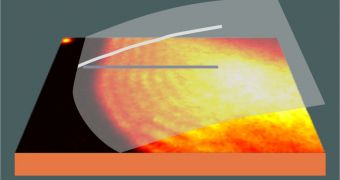They're not exactly 3D movies of molecules dancing, but the new 3D images of the nanoworld are being created starting from regular 2D pictures taken by the best microscopes. Researchers created a new imaging technique that transforms still two-dimensional pictures of nanoscale structures, several billionths of a meter long into three-dimensional pictures.
Unfortunately, no such 3D movie was published yet, but David Jesson and his team at Monash University in Australia, was able to reconstruct the heights of tiny droplets seen in microscope pictures, which could become a helpful tool for scientists wanting to watch technological processes like semiconductor growth as they happen.
Previously, other imaging techniques such as atomic-force microscopy and scanning tunneling microscopy allowed scientists to create three-dimensional maps of tiny structures with high accuracy, but unfortunately they don't work for the fast-moving events. The new method is called photoemission electron microscopy, or PEEM and is the first so far to solve the speed problem. To do that, this technique shines high-energy light on an entire sample, instead of sequentially measuring the height at each point of the structure.
Electrons are ejected by that light and are focused to produce a video of a large portion of the sample in real time. This is very useful, as it can create live movies of growing crystals or the shifting of magnetic domains and even an oscillating droplet.
The latter was observed by the team of researchers and was made of liquid gallium on a flat substrate of gallium arsenide, just like raindrops would form on the hood of car. By looking at the images, they observed dark and bright bands that traced the boundaries of each droplet.
"It was something that was very unexpected, and we figured we should really sort it out," says Jesson. These bands look very much like lines on topographic maps, which indicate different altitudes, so they used this model to transform the still pictures into three-dimensional images.
"All we have to do, in principle, is count the fringes to get the height," says Jesson. "Other PEEM researchers have noticed the fringes, but until now they weren't considered useful. I suspect they regarded them as a nuisance," he added.
This new method could have applications in nanoscopic imaging where information regarding depth is extremely valuable.

 14 DAY TRIAL //
14 DAY TRIAL //